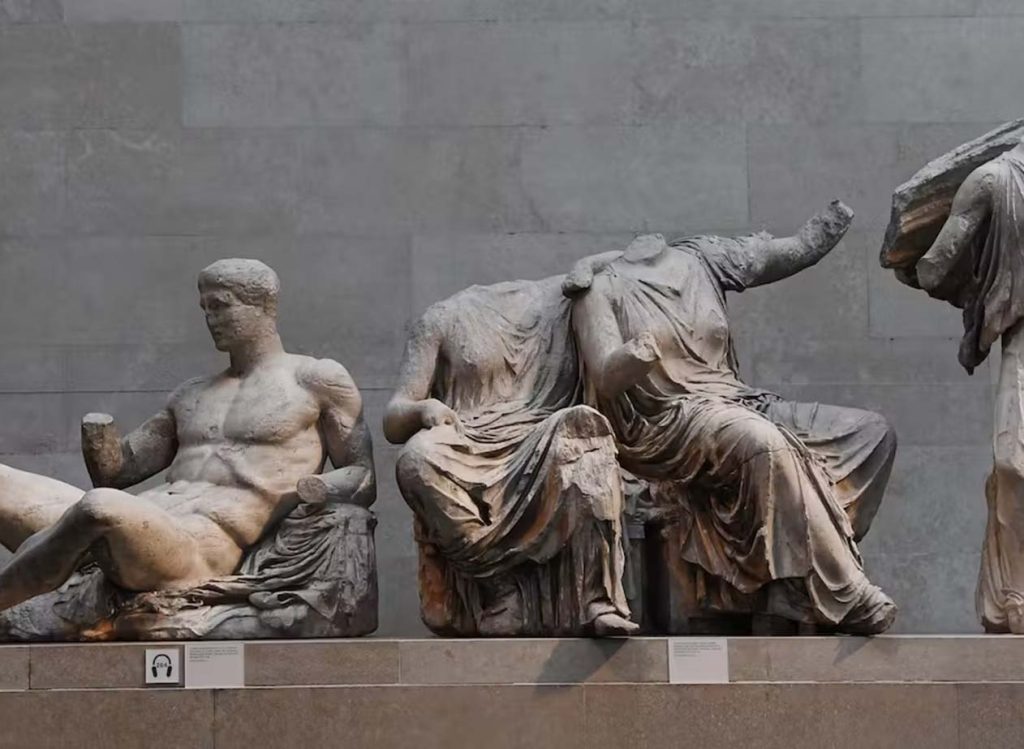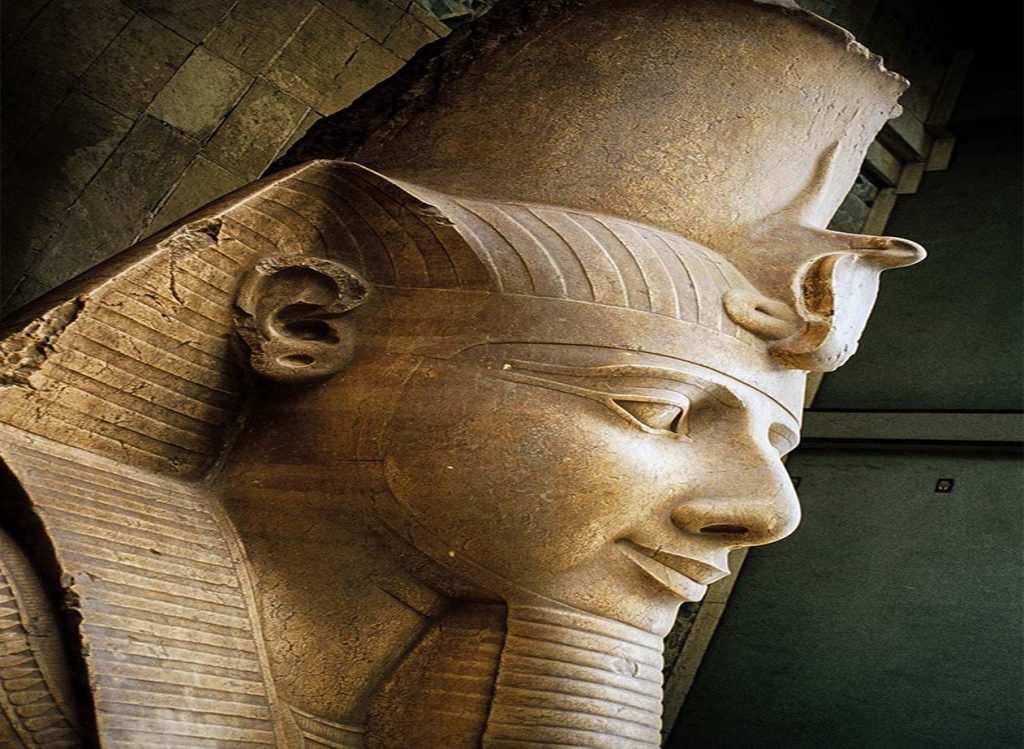The museum houses an astonishing collection of artifacts and treasures from all corners of the world, spanning thousands of years of human history. I’ll share some of the most awe-inspiring pieces I encountered during my visit.
The Rosetta Stone:
My journey through the British Museum commenced with a captivating encounter with the Rosetta Stone, an archaeological gem of unparalleled significance. This unassuming slab of black basalt served as the linchpin in unraveling the enigmatic world of ancient Egypt. The stone is inscribed with a decree issued in 196 BC, during the reign of King Ptolemy V, in three scripts: hieroglyphs, demotic script, and ancient Greek. This trifecta of scripts was the Rosetta Stone’s gift to posterity, as it provided scholars with the key needed to decode the mysteries concealed within the hieroglyphic script
Standing in its presence was nothing short of awe-inspiring. The stone’s dense hieroglyphic text, etched with meticulous precision, encapsulates centuries of history, religious beliefs, and the names of pharaohs, all sealed away until the stone’s discovery in 1799. The Rosetta Stone, in its quiet stoicism, testifies to the relentless curiosity of humankind and the indomitable spirit of decipherment that led to the decoding of ancient Egyptian hieroglyphs. It’s a testament to the tireless work of scholars like Jean-François Champollion, who, in 1822, finally cracked the code.
The Sophilos Vase:
Moving on, I ventured into the realm of ancient Greece, where the Sophilos Vase awaited with its intricate beauty and the tales it had to tell. Crafted in the 6th century BC, this Greek pottery masterpiece offers a vivid window into the storytelling traditions of a bygone era.
The vase’s craftsmanship is extraordinary. Its surface is adorned with meticulously painted figures and scenes, a striking testament to the artistic skills of its creator. The artwork depicts mythological stories and epic battles, paying homage to the gods and heroes that were central to Greek culture.
As I gazed upon the vase, I was transported to an ancient world, where each brushstroke seemed to breathe life into the figures. The vibrant colors, despite their age, still retained their vibrancy, testifying to the enduring artistry of the ancient Greeks.
The Sophilos Vase is more than just a piece of pottery; it’s a portal to the rich tapestry of Greek mythology, history, and culture. It serves as a reminder that even in fragments of clay, we can discover the stories and values that have shaped the course of human history. This splendid artifact is a treasure trove of Greek heritage, a testament to the timeless appeal of the classical world, and an enduring connection to a civilization that continues to captivate our imaginations.
The Parthenon Sculptures:

As I continued my journey through the hallowed halls of the British Museum, I was drawn to the Parthenon Sculptures, a mesmerizing collection of marble masterpieces that once adorned the iconic Parthenon temple in Athens. The aura of ancient Greece surrounded me as I gazed upon these exquisite carvings, each a testament to the boundless artistic prowess of the ancient Greeks.
These sculptures, despite being separated from their original home, retain their captivating beauty. They depict various mythological scenes and events, including battles, gods, and heroic figures. The intricacy and detail in each piece are astounding, and it’s evident that the sculptors of ancient Greece possessed a remarkable ability to capture the essence of their subjects.
For me, these sculptures transcended mere works of art; they were gateways to the myths and legends that continue to shape our cultural imagination. These fragments, once integral to the magnificent Parthenon, are a living testament to the enduring legacy of Greek culture and its impact on the world.
Grayson Perry’s “The Tomb of the Unknown Craftsman”:
Leaving the ancient world behind, I came across Grayson Perry’s “The Tomb of the Unknown Craftsman,” a contemporary masterpiece that pays homage to the countless artisans who have toiled in the shadows of history. This intricate work of art weaves together elements from various cultures and eras, creating a striking mosaic of human creativity.
Perry’s creation is a heartfelt tribute to the craftsmen and craftswomen who, though their names may be forgotten, have left their mark on the world through their creations. It serves as a reminder that the beauty of art lies not just in the finished product but also in the hands and minds that bring it to life. In this piece, the past and present converge in a harmonious celebration of human ingenuity.
The Crouching Venus:
The Crouching Venus, with her delicate form and sensual grace, offered a stark contrast to the monumental sculptures and contemporary art I had encountered. This elegant piece, sculpted during ancient times, is a testament to the enduring fascination with the human body in art.
As I admired the sculpture, I couldn’t help but marvel at the craftsmanship that had gone into creating it. The attention to detail, from the intricately carved hair to the subtle curvature of the body, was nothing short of remarkable. The Crouching Venus stands as a testament to the appreciation of beauty and sensuality that has transcended the ages and continues to inspire artists and admirers alike.
The Statue of Ramesses II:

No visit to the British Museum would be complete without a rendezvous with the colossal statue of Ramesses II, one of ancient Egypt’s most illustrious pharaohs. This regal figure, although incomplete, exudes a sense of majesty and grandeur that leaves an indelible impression.
The colossal statue stands as a tribute to the power and influence of the mighty Ramesses II, whose reign spanned more than six decades. The intricacies of his regal attire, the hieroglyphics inscribed upon his statue, and the aura of divine authority that envelops him make it a remarkable historical artifact.
Standing before this ancient monarch, I couldn’t help but feel humbled by the grandeur of his reign and the testament to the enduring legacy of the pharaohs of Egypt. The statue of Ramesses II is a living testament to the grandeur of ancient Egypt, and it reinforces the British Museum’s status as a keeper of human history and artistry.
The Ife Head:
My exploration of the British Museum led me to the Ife Head, a remarkable copper sculpture that hails from Nigeria. This stunning artifact is a testament to the advanced artistic and metallurgical skills of the Ife people, one of Africa’s most ancient and culturally rich civilizations.
The intricacy of this sculpture left me in awe. The finely detailed facial features, including the eyes, nose, and mouth, showcase the Ife people’s exceptional craftsmanship. The level of detail and realism in this piece is remarkable, and it offers a glimpse into the artistic standards of ancient West Africa.
The Ife Head stands as a testament to the Ife civilization’s mastery of metalwork and their ability to create art that captures the essence of humanity. Its historical value cannot be overstated, as it sheds light on the rich artistic and metallurgical traditions that have been an integral part of African history.
The Tree of Life:
My next encounter was with the Tree of Life, an ivory panel from the Assyrian era. This enchanting piece beckoned me into the world of Mesopotamia and its unique cultural symbolism.
The Tree of Life is adorned with intricate carvings that tell a story of fertility and growth, themes that were central to Mesopotamian culture. It is a testament to the artistry and symbolism of this ancient civilization, showcasing the importance of the natural world in the Mesopotamian understanding of life and the afterlife.
This panel is a striking reminder of the enduring fascination humans have had with the cycle of life and the interconnectedness of all living things. It serves as a bridge between modern visitors and the people of ancient Mesopotamia, offering insights into their beliefs and values.
The Aztec Drum:
Continuing my journey, I found myself captivated by the Aztec Drum, a mesmerizing piece adorned with intricate carvings that vividly depict the world of the Aztec people. This artifact brought to life the rich cultural heritage of the indigenous peoples of Mesoamerica.
The drum’s carvings reveal a wealth of information about Aztec traditions, from the depiction of deities and mythological creatures to scenes of daily life. The meticulous attention to detail and the profound significance of the symbols carved into the drum highlight the depth of the Aztec belief system.
This piece is not just a work of art but a window into the spiritual and cultural life of the Aztec civilization. It serves as a powerful reminder of the intricate and profound belief systems of indigenous Mesoamerican cultures.
The Aztec Serpent:
The Aztec collection continued with the Aztec Serpent, a sculpture that exudes power and symbolism. This piece is a testament to the complexity of Aztec religious beliefs and their deep reverence for animals, which were central to their cosmology.
The serpent, often associated with fertility, life, and death, played a significant role in Aztec mythology. The sculpture’s intricate detailing, including the serpent’s scales and the motifs adorning it, tell stories of creation and the ever-turning cycles of life.
Standing before this imposing sculpture, I was reminded of the intricacies of Aztec spirituality and the enduring importance of their traditions. The Aztec Serpent is a testament to the enduring legacy of indigenous cultures in the Americas.
The Pilaneesi Vase:
My journey through the British Museum concluded with the Pilaneesi Vase, an Etruscan artifact that captured my attention with its intricate designs and vibrant colors. This beautiful piece is a testament to the craftsmanship of the ancient Italian civilization of the Etruscans.
The vase’s intricate patterns and vibrant colors were a feast for the eyes. It showcased the Etruscan’s remarkable skill in pottery and their ability to create art that was both functional and visually stunning. The motifs on the vase hint at the Etruscan’s rich cultural and artistic traditions.
As I admired this Etruscan masterpiece, I was reminded of the cultural diversity and artistic ingenuity of ancient Italy. The Pilaneesi Vase stands as a testament to the Etruscans’ contributions to the art and culture of the ancient Mediterranean world and their role as precursors to the Roman civilization that would eventually dominate the region.
The Edmond Val’s Exile Library:
As I delved deeper into the British Museum’s vast collection, I stumbled upon a treasure that celebrated the enduring power of literature and knowledge – Edmond Val’s Exile Library. This repository of books and manuscripts is a testament to the quest for enlightenment and the preservation of human thought through the ages.
The library contains a diverse array of texts, each with its own story and significance. It is a living record of the ideas, stories, and knowledge that have shaped human history. In a world where the printed word has become increasingly digitized, Edmond Val’s Exile Library serves as a poignant reminder of the timeless value of books and the vital role they play in our intellectual and cultural evolution.
In this sanctuary of knowledge, I was reminded of the boundless capacity of human curiosity and the unquenchable thirst for wisdom that transcends time and place. The library is a tribute to the enduring pursuit of enlightenment and the indomitable spirit of those who have contributed to our collective understanding of the world.
The Haida Totem Pole:
My journey through the British Museum led me to the Pacific Northwest, where I was greeted by the majestic presence of a Haida Totem Pole. This towering symbol of the indigenous Haida people is not merely a work of art; it is a living testament to the rich cultural heritage of North America’s First Nations.
The totem pole, standing tall and adorned with intricately carved symbols and figures, tells the stories and traditions of the Haida people. Each carving represents a lineage, a legend, or a sacred creature. As I gazed upon the totem pole, I felt a profound connection to the history and spirituality of the Haida people, whose traditions have been passed down through generations.
This remarkable artifact is a reminder of the enduring significance of indigenous cultures and their contributions to the tapestry of human history. The Haida Totem Pole stands as a symbol of resilience, cultural pride, and the importance of preserving the heritage of North America’s First Nations.
The Hoa Haka Nana’ia:
My journey through the British Museum reached its conclusion with a captivating encounter with the Hoa Haka Nana’ia, a moai statue from Easter Island. This solitary sentinel from a remote Pacific island held within it the mysteries and history of an ancient civilization.
The moai statue, with its distinctive features and enigmatic aura, is a representation of the Rapa Nui people’s artistic and spiritual expression. It is a symbol of their connection to the land and the reverence they held for their ancestors. The statue’s name, “Hoa Haka Nana’ia,” translates to “stolen or hidden friend,” hinting at a history of displacement and loss.
As I stood before this silent guardian, I couldn’t help but ponder the remarkable achievements of the Rapa Nui people and the mysteries that still shroud their culture and the construction of these monumental statues. The Hoa Haka Nana’ia is a poignant reminder of the enduring fascination with Easter Island and the need to preserve its rich heritage.
My journey through the British Museum was a voyage through time and across the globe. Each artifact I encountered told a unique story of human history, art, culture, and knowledge. The museum’s collection is a testament to the rich tapestry of human civilization, offering visitors a profound connection to the past and an appreciation for the diversity and creativity of the world’s cultures. It is a sanctuary of history, a treasure trove of human achievement, and a place where the wonders of the past come to life.



